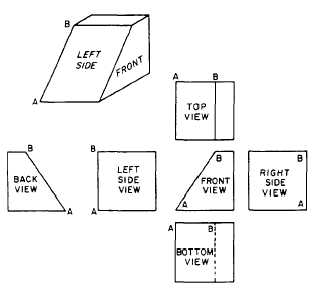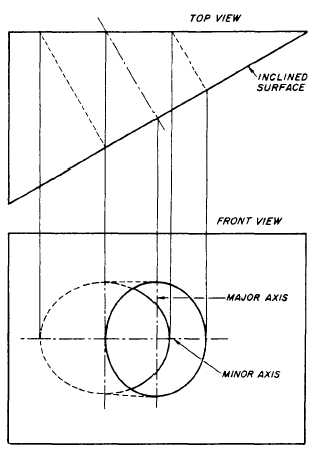Many objects, however, have no definite top,
bottom, front, or back—as many types of
machine parts, for example. With an object of
this kind, you can select a surface and call it the
front, and select another and call it the top,
according to convenience. However, it is a general
rule that an object should be shown in the
position it customarily occupies.
One-view drawings are permissible for objects
for which one view and such features as thickness
or length, stated as a dimension or note, can
completely define the object.
NORMAL AND NON-NORMAL LINES.—
In a multi-view orthographic projection, a
NORMAL line is one that is parallel to two of
the planes of projection and perpendicular to the
third. A line that is parallel to a plane of
projection will appear on that plane in its true
length (to the scale of the drawing). A line that
is perpendicular to a plane of projection will
appear on that plane as a point.
A line that is perpendicular to one plane of
projection must of necessity be parallel to the
other two. But a line that is parallel to one plane
of projection may be oblique (neither parallel nor
perpendicular) to one or both of the others. A line
that is oblique to one or more of the planes of
projection is called a NON-NORMAL LINE.
If a non-normal line is parallel to a plane of
projection, it will appear on that plane in its true
length. However, it will appear foreshortened in
Figure 5-20.-Foreshortening of a line in
projection.
a multi-view
a view on a plane to which it is oblique. A non-
normal line may, of course, be oblique to all three
planes of projection, in which case it will appear
foreshortened in all regular views of the object.
A REGULAR VIEW is a view on one of the three
regular planes of projection (horizontal, vertical,
or profile). Views on planes other than the regular
planes are called AUXILIARY VIEWS. Auxiliary
views will be discussed later in this chapter.
A single-view projection of a block is shown
in the upper left corner of figure 5-20. This
block is presumed to be placed for multi-view
projection with the front parallel to the vertical
plane, the bottom parallel to the horizontal plane,
and the right side parallel to the profile plane. The
line AB, then, is parallel to the vertical plane, but
oblique to both the horizontal and the profile
planes.
In the multi-view projections, you can see that
it is only in the views on the vertical plane (the
front and back views) that the line AB appears
in its true length. In the views on the horizontal
Figure 5-21.-A circle on a surface oblique to the plane of
projection projected as an ellipse.
5-12




